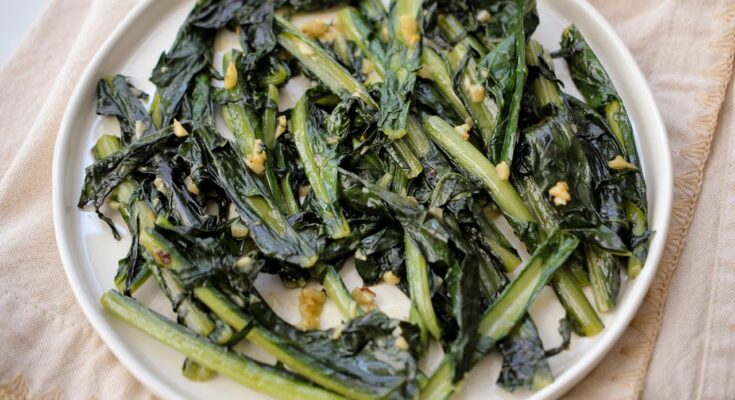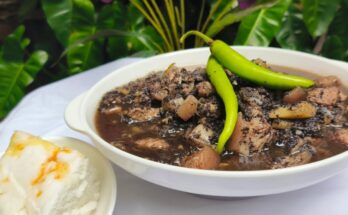Dandelion Greens Recipe: Cooking with dandelion greens might sound unusual, but once you try them, you’ll understand why they’re loved by food enthusiasts and health-conscious cooks alike. These leafy greens are not only flavorful but also packed with nutrients. Think of them as nature’s secret ingredient hiding in plain sight in your backyard or local farmer’s market. Their slightly bitter taste makes them unique, and with the right preparation, you can turn them into a delicious side dish or even the star of your meal.
What are Dandelion Greens?
Dandelion greens come from the same plant that produces the yellow flowers you see in spring. They are edible leaves with a flavor that’s often compared to arugula or kale but with a more pronounced bitterness. Traditionally, they’ve been used in Mediterranean, Asian, and even Native American cuisines for centuries. Unlike lettuce or spinach, dandelion greens bring a stronger punch to dishes, making them perfect for people who enjoy bold, earthy flavors.
Health Benefits of Dandelion Greens
Dandelion greens are a powerhouse of nutrition. They’re loaded with vitamins A, C, and K, along with calcium, potassium, and iron. These nutrients support bone health, immunity, and digestion. They’re also rich in antioxidants, which help fight inflammation and protect against chronic diseases. Plus, dandelion greens act as a natural detoxifier, supporting liver health. Adding them to your diet is like giving your body a superfood boost without spending a fortune on fancy supplements.
Ingredients You’ll Need
Before diving into the cooking steps, let’s break down what you’ll need. The beauty of this recipe is that it’s simple, wholesome, and customizable.
Fresh Dandelion Greens
The star of the dish is, of course, fresh dandelion greens. Ideally, choose young, tender leaves since they’re less bitter and easier to cook. You can find them at farmer’s markets, specialty grocery stores, or even harvest them from your garden (just make sure they’re pesticide-free).
Common Pantry Staples
To balance the natural bitterness of the greens, you’ll need some basic pantry staples:
- Olive oil (for sautéing and adding richness)
- Garlic (to add depth and aroma)
- Salt and black pepper (to season)
These are the essentials that form the base of most dandelion green recipes.
Optional Flavor Enhancers
To give your dish more character, you can add:
- Lemon juice (for brightness and acidity)
- Red pepper flakes (for a little heat)
- Parmesan cheese (for a savory finish)
- Onions or shallots (for sweetness to balance bitterness)
These extras can transform your greens from simple to sensational, depending on your taste preference.
Preparing Dandelion Greens
Cooking dandelion greens starts with proper preparation. If you skip this step, the bitterness can be overwhelming.
How to Select the Best Dandelion Greens
Always choose young, fresh leaves. They should be bright green, crisp, and free from yellow spots or wilting. Older leaves are much more bitter and tougher to chew. If you’re harvesting them yourself, pick them before the plant flowers, since once dandelions bloom, the leaves turn very bitter.
Washing and Cleaning the Greens
Because dandelion greens often grow close to the ground, they can collect a lot of dirt. Rinse them thoroughly in cold water to remove grit and soil. Soaking them in a bowl of salted water for 10–15 minutes can also help reduce bitterness.
Trimming and Prepping for Cooking
Trim off any tough stems, especially if you’re using mature leaves. Chop the greens into manageable pieces, usually 2–3 inches long. Having them prepped and ready makes the cooking process smoother and faster.
Step-by-Step Guide to Cooking Dandelion Greens
Now that your ingredients are ready, let’s move on to cooking. This method ensures that the greens turn out flavorful, tender, and perfectly balanced.
Step 1 – Blanching the Greens
Start by blanching the dandelion greens in boiling water for 2–3 minutes. This step softens the leaves, reduces bitterness, and gives them a vibrant green color. After blanching, quickly transfer them into a bowl of ice water to stop the cooking process. Drain well before moving to the next step.
Step 2 – Sautéing for Flavor
Heat olive oil in a large skillet over medium heat. Add garlic (and onions if you’re using them) and sauté until fragrant. Then, add the blanched dandelion greens and cook for about 5–7 minutes, stirring occasionally. This step allows the flavors to meld and the greens to absorb the richness of the oil and garlic.
Step 3 – Adding Seasonings and Spices
Season the greens with salt, pepper, and any optional enhancers like red pepper flakes or lemon juice. Toss everything together until well combined. If you enjoy a creamy finish, sprinkle in some grated Parmesan cheese.
Step 4 – Serving Suggestions
Dandelion greens make a versatile side dish that pairs well with grilled chicken, roasted fish, or even pasta. You can also serve them over rice, in wraps, or as part of a warm salad.
Tips for Perfect Dandelion Greens Every Time
Cooking dandelion greens doesn’t have to be tricky. Here are some tried-and-true tips:
Balancing Bitterness
Blanching is the key to taming bitterness, but you can also balance it with sweet or acidic flavors like caramelized onions, tomatoes, or lemon juice.
Pairing with Other Dishes
Think of dandelion greens as you would spinach or kale. They pair beautifully with proteins like chicken, beef, or fish and can be tossed into pasta, stews, or stir-fries.
Storage and Reheating
Store cooked dandelion greens in an airtight container in the fridge for up to three days. To reheat, sauté them in a pan with a splash of olive oil instead of microwaving to preserve their texture and flavor.
Variations of Dandelion Greens Recipes
The beauty of cooking with dandelion greens is that you can easily adapt the recipe to your personal taste. Below are some delicious variations that bring out the unique flavor of these greens while keeping them exciting and versatile.
Garlic and Olive Oil Dandelion Greens
This is the simplest and most traditional way to prepare dandelion greens. After blanching, sauté them in olive oil with plenty of garlic. Add a pinch of salt, black pepper, and a squeeze of lemon juice for brightness. The garlic softens the bitterness while the olive oil coats the leaves with a silky texture. This recipe pairs perfectly with grilled meats, roasted vegetables, or even served as a side with bread. It’s quick, wholesome, and packed with Mediterranean vibes.
Dandelion Greens with Lemon and Chili Flakes
For those who like a little kick, this version adds heat and tang. Once the greens are sautéed, toss them with red chili flakes and freshly squeezed lemon juice. The citrus cuts through the bitterness, and the chili adds warmth, making the dish bold and flavorful. You can also sprinkle in some toasted sesame seeds or crushed nuts for extra crunch. This variation works great as a zesty side for fish or poultry.
Dandelion Greens Soup
If you’re in the mood for something comforting, dandelion greens make an excellent addition to soups. You can simmer them with vegetable or chicken broth, garlic, onions, and potatoes for a hearty meal. Add beans or lentils for protein, and finish with herbs like thyme or parsley. The soup is not only nourishing but also perfect for colder months when you want something warm and wholesome.
Nutritional Value of Dandelion Greens
Dandelion greens are more than just a tasty addition to your meals—they’re a nutritional powerhouse.
Vitamins and Minerals
These greens are incredibly rich in vitamin A, which supports vision and skin health. They also pack vitamin K, essential for blood clotting and bone strength, along with vitamin C, which boosts immunity. Minerals like calcium, iron, and potassium make them excellent for maintaining strong bones, oxygen circulation, and heart health.
Antioxidant Properties
One of the most remarkable things about dandelion greens is their antioxidant content. They contain beta-carotene, lutein, and polyphenols, which help combat oxidative stress and inflammation. This means they can play a role in reducing the risk of chronic diseases such as diabetes, heart disease, and even certain cancers.
Benefits for Digestion
Dandelion greens also act as a natural digestive aid. Their high fiber content supports gut health, while their natural compounds promote bile production, which helps the body digest fats more efficiently. This makes them not just a tasty ingredient but also a functional food that benefits your overall well-being.
Common Mistakes to Avoid When Cooking Dandelion Greens
Even though cooking dandelion greens is simple, there are some common pitfalls you should avoid to make sure your dish comes out perfect every time.
Overcooking the Greens
One of the biggest mistakes is cooking them too long. Overcooked greens lose their vibrant color, turn mushy, and become even more bitter. The goal is to keep them tender yet slightly crisp. A quick sauté after blanching is usually enough.
Using Too Much Salt
Because dandelion greens already have a strong flavor, adding too much salt can overwhelm the dish. Start with a small amount and adjust after tasting. If you need more flavor, balance with herbs, lemon juice, or garlic instead of loading up on salt.
Ignoring Flavor Balancing
Bitterness is the defining taste of dandelion greens, but it should never dominate the dish. Always balance it with acidity (like lemon juice or vinegar), sweetness (like caramelized onions), or richness (like olive oil or cheese). Ignoring this balance can leave your dish tasting harsh and unappealing.
FAQs about Dandelion Greens Recipe
Can you eat dandelion greens raw?
Yes, young and tender dandelion greens can be eaten raw in salads. They add a peppery, slightly bitter bite similar to arugula. For mature leaves, it’s best to cook them to mellow out the bitterness.
Are dandelion greens safe for everyone?
Generally, yes. However, people with allergies to related plants (like ragweed) or those on certain medications should consult a doctor before consuming large amounts. Since dandelion greens act as a natural diuretic, they may interfere with water pills or medications.
How do you store leftover cooked dandelion greens?
Store them in an airtight container in the fridge for up to three days. For longer storage, you can freeze blanched greens in freezer bags for up to three months.
What’s the best way to reduce the bitterness?
Blanching the greens before sautéing is the most effective method. Pairing them with acidic or sweet ingredients like lemon juice, balsamic vinegar, or caramelized onions also helps balance the flavor.
Can you harvest dandelion greens from your backyard?
Yes, but only if you’re certain they haven’t been sprayed with pesticides, herbicides, or other chemicals. Always harvest young leaves before the plant flowers for the best taste.
Conclusion
Dandelion greens are a hidden gem in the world of leafy vegetables. With their earthy, slightly bitter flavor and incredible nutritional benefits, they deserve a place in your kitchen. By following the step-by-step guide, you can transform these humble greens into a delicious dish that’s both healthy and satisfying. Whether you sauté them with garlic and olive oil, spice them up with chili and lemon, or simmer them into a hearty soup, there are endless ways to enjoy their unique taste.
So, the next time you see dandelion greens at your local market—or growing in your yard—don’t pass them by. Bring them into your kitchen, cook them with love, and enjoy a plate full of flavor and health.



